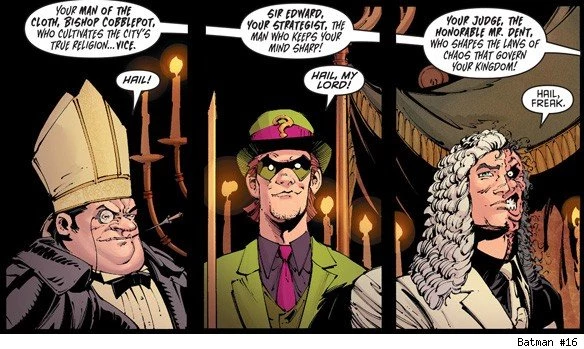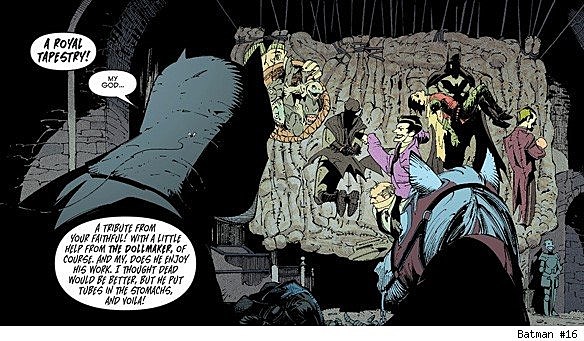![Scott Snyder On ‘Death Of The Family': ‘If I Only Had One Chance, This Is What I’d Do’ [Interview]](http://townsquare.media/site/622/files/2013/02/dotf01.jpg?w=980&q=75)
Scott Snyder On ‘Death Of The Family': ‘If I Only Had One Chance, This Is What I’d Do’ [Interview]

This week, "Death of the Family" came to its conclusion in Batman #17, putting an exclamation point on the first big Joker story since DC's relaunch in 2011. Over the course of five issues, Scott Snyder and Greg Capullo sent Batman's arch-nemesis after the Dark Knight's family of sidekicks, creating what Snyder called a "twisted love letter" from the Joker, designed to strengthen Batman by freeing him of "weaknesses" like Robin, Nightwing and even Alfred -- getting caught up in questions of secret identities and psychological scars along the way.
Now that it's all over, we spoke to Snyder about what he felt like he accomplished by being the architect of the Joker's return, how he approached the horror aspects of the story, and what he's planning to do next.ComicsAlliance: Now that "Death of the Family" is over, do you feel like you accomplished your goal? Was this you really wanting to do your definitive Joker story?
Scott Snyder: Yeah, it definitely was. It might just be me being neurotic or anxious, but I try to approach every story on Batman like they're going to kick me off right afterwards, you know? I can't believe I get to go to work and write Bruce Wayne every day, so honestly, my big fear was that I won't get a chance to do it again. I feel like you have to approach characters like the Joker, the Riddler or Batman like, if I only got one chance to write this character, this is the story I would do.
It is meant to be my definitive Joker story, for me personally, but the irony is that while I was getting to #17, I had another idea for another Joker story. Hopefully I'll get to use him again, and then I'll be saying that again at that point, too.
CA: Was this a story that you wanted to do for a while? It feels very much like you had an idea of how the Joker should work, and I know you were a big Batman fan to begin with, so was this always the way you saw him working and the way you wanted to explore his character?
SS: I've always wanted to write him, but I kind of found a way to be able to at least approach writing him when I was doing Detective Comics, and I was writing "The Black Mirror." He has a cameo at one point, and I loved writing him so much, and my take on him formed there in a way that really excited me about being able to use him again.

When we did the New 52, they said they wanted to take a lot of the known villains off the table so that we could create our own, and I was already doing "Court of Owls," so I was like "That's totally fine with me, but can I get dibs on the Joker when he comes back?" DC was totally cool about it, so I started to form this story, "Death of the Family," talking to Pete Tomasi and Kyle Higgins and a couple of the other creators. All the way back at the beginning, we were talking about "Death of the Family," and I developed it myself as we got closer. It was something I've been dying to do for a really long time, and I'd thought about and mulled over in my brain for a lot of months. It's really interesting to finally be finished with it after you live with it for so long.
CA: Why did you want to organize the story in terms of that royal court structure that the villains have? Why was that the approach you wanted to go with? Is that how those relationships jumped out at you as a reader?
 SS: For me, the way I got my take on the Joker was personal, the way I try to approach each arc of Batman. I try to look at it and say, where's Bruce in his trajectory right now, emotionally, and how do I relate to that and build a story that's going to be really deeply frightening to me? This was a sort of perfect storm, where Bruce has accumulated this amazing family, and I just had a second child. He just relied on that family very heavily in "Night of the Owls," and it was the sort of thing where I was thinking to myself "I wish I could stop worrying about my kids for a little while," and I got to thinking that Batman must feel the same way about his family after they were in danger during "Night of the Owls." Who would hear that and come in and say "I heard you say that, I heard you think that horrible thing, that you wished you could stop caring and loving your family. I'll make that possible," by basically axing all of them. The Joker. That's perfect.
SS: For me, the way I got my take on the Joker was personal, the way I try to approach each arc of Batman. I try to look at it and say, where's Bruce in his trajectory right now, emotionally, and how do I relate to that and build a story that's going to be really deeply frightening to me? This was a sort of perfect storm, where Bruce has accumulated this amazing family, and I just had a second child. He just relied on that family very heavily in "Night of the Owls," and it was the sort of thing where I was thinking to myself "I wish I could stop worrying about my kids for a little while," and I got to thinking that Batman must feel the same way about his family after they were in danger during "Night of the Owls." Who would hear that and come in and say "I heard you say that, I heard you think that horrible thing, that you wished you could stop caring and loving your family. I'll make that possible," by basically axing all of them. The Joker. That's perfect.
For me, the idea is that I try to approach it from a very personal place, and try to write Batman from a standpoint where I'm investing my own anxieties and nightmares and fantasies into these storylines, and hopefully still doing something that speaks to where the character is in his own life as Bruce Wayne.
CA: Along those same lines, there were parts of this where you didn't just deal with the Joker, you had Two-Face, the Riddler, the Penguin, Harley Quinn. Was there anyone that you felt like you wanted to expand on, or that you plan on dealing with again in those terms in the future?
SS: Definitely. I've teased before that we're going to use the Riddler, and Harley is a character that I'd love to use again. I have an idea for the Penguin... the rogues are endlessly fascinating to me. The thing that makes them so great is that they're these creations of Gotham City that represent these fears Bruce has about himself. Joker, to me, is the core of that. He's the thing that announces that in this storyline, he's the one that articulates it and says "Each of us is a facet of your own weaknesses. We test your strength." Penguin is the one who rules over the religion of Crime in Gotham, challenges you by bringing these gang wars and this rampant crime and vice. Riddler is the strategist, the one who challenges your intelligence and your wit, and if you can't keep up with him, you go down.

In that way, every rogue really is representative of a fear Batman has about himself, and speaks to a different strength he has. There isn't one that I wouldn't love to use, from Ivy to Clayface, and there are plans for a lot of them coming up, with one in particular taking center stage this year.
CA: Joker was obviously the focus, Riddler, Two-Face and the Penguin were kind of the second tier, but there were also cameos from Mr. Freeze and Clayface. Was there anyone you wanted to use, but just could not fit in the story?
SS: Yeah! I mean, I wanted to use Killer Croc, and I couldn't fit him in. I wanted to use Zsasz at one point. I literally just could not get them in there, it was pretty packed as it is. I feel like it's a pretty compressed story with a very fast pace, but they'll get their time in the sun. I promise.
CA: But no KGBeast, huh?
SS: [Laughs] No KGBeast yet. I always liked the KGBeast, dude. I was a kid and I was so into that Cold War stuff, I was crazy about him.
CA: The last time we talked, closer to the beginning of "Death of the Family," I called what you were doing a "horror movie take on the Joker." You've talked about using your own fears and anxieties, and especially once it gets to the Arkham Asylum parts in #16, there's a lot that goes into a more grotesque sort of horror.
SS: Yep.
CA: There's the stitched-together tapestry of guys who were inmates, the people who are forced to dance on penalty of electrocution... What was the process of deciding you wanted to go with that kind of imagery? Was there anything you wanted to do that DC was like "no, that's too far"?

SS: You know, I do sometimes worry that we go too far here and there, but what I try to do is work it along a theme. Each issue is about exploring that same kind of emotional conflict in a different way, and that issue to me was really about the Joker saying "This is the castle I built for you that you want for yourself," and in that way, he's making it Frankenstein's castle. There's a heavy Frankenstein theme in that one, where it's meant to be something where the Joker really believes that Batman is the walking dead, that he lost his spark and his fire because he has this family that makes him an old, slow, weak man. He wants to shock him back to life.
It's meant to feel like a horror movie castle and have that feel of people sewn together, and abnormal brains, and all kinds of gruesome transformations, and all of that. There are definitely moments where I look at it and go "I can't believe we did that. Is that too Human Centipede?" [Laughs] At the end of the day, I feel okay with it because we are doing it to shock you. We are trying, for better or for worse, whether we make missteps along the way, to lash all of it to a really specific vision that the Joker has, and to really tie it into what the story's about for us in a really specific way.
Like I was saying, even though the Joker does these gruesome things, tying or stitching these people up -- they willingly did it, by the way -- even though he does this thing where he lashes them together into this tapestry, it's meant to be part of a larger picture, which is him saying "that's the kind of beautiful art on the wall that reminds us of the wonderful times we've had together." It's not just meant to be something gruesome or grotesque that you see as a reader and think to yourself, oh that's awesome, that's shocking, I like it or I don't because I like graphic horror, it's meant to be in service of a larger message that the Joker's been saying since issue 1.
CA: Getting into a few of the specifics on how it all ends, you do tease a lot of stuff in the early parts. There's the tease of whether the Joker knows who Batman is when he comes after Alfred, there's the bit about how he maybe got into the Batcave all those years ago. By the end of it, you do address all that. You establish and firmly root things in a way that there's not a lot of going back from. Was that you wanting to leave your stamp on it? Was it something encouraged by the editors, to say that no, we'll never know what the Joker's deal really is?
SS: It's pretty much all me. I mean, DC has been pretty generous to me about letting me make my own mistakes, I guess. [Laughs] These books succeed or fail, I'm on my own with it, so I've been very fortunate in that regard. When it comes to this one, it was really just a function of trying to write it in a way that would be the Joker story I'd write if I only got one chance to write the character. It has that kind of feel, at least that it's almost the final battle between them in some ways, but at the same time, I wanted to be able to explore it and leave the characters there for other people to use, should they want to, and do their own takes on it. They're endlessly interesting in that way, and I'm always inspired when someone takes the Joker and does something I'd never do with him, or with Batman.
I wasn't interested in taking the Joker and literally killing him, or having Batman find out that he'd killed Alfred. Those kinds of things, to me, are easily undone, you know? Those kinds of wounds inflicted on Batman and the Bat Family. So for me, it was more about trying to reach a little deeper, and have the Joker cut them in a way that wouldn't be healed so easily. It would have more resonance than "well, you know, we've cut off somebody's face." You kill someone in comics, who's to say that you can't dip them in a Lazarus Pit, or sew the face back on with some kind of laser stitching machine, or get a magical character to put it back on? I wanted to make it an emotional and psychological wound that he inflicted that'll have lasting repercussions in the series from here forward.
If it does have that feeling, it definitely wasn't pushed on me by the editors. It is, for better or worse, the story that I would tell if I only got one chance to tell a Joker story, so I hope you guys really like it. I appreciate everyone being so supportive from the beginning.
CA: You said you had more ideas for the Joker as you were writing this story. If you get the chance to use him again, would you want to explore more of this kind of Joker, or take advantage of how he can change in every appearance? Is there pressure to make him scarier and more violent and more grotesque every time? Have you said all you want to say with this version, or would you want to reinvent him again?
SS: Oh, I'd reinvent him, 100%. I have an idea already that takes him in a whole different direction. That's what I love about that take on him that Grant Morrison created, where he's reborn all the time as a new self, that kind of hyper-self, hyper-sense of identity. For me, it's a generous way of defining him, because it allows all of us to make up our own takes and have them all be "true." The next time I use him, I promise he'll come back from a different and hopefully equally terrifying angle.
He's the first character I've used and put away and wanted to do more with. When I used James Jr. and put him away, I was ready to let him rest and not go back to him for a while. The Joker's the first character that I put down and immediately wanted to pick back up. Hopefully I'll get to soon, and again, I can't thank you guys enough out there for supporting this one. I hope you enjoyed #17.
CA: I really did, and I know we didn't really have time to address it, but Greg Capullo's been doing an amazing job on this book.
SS: He is a superhero unto himself, and I have to give him a shoutout. He's my partner in crime, and has one of the most wonderfully twisted and inspiring artistic minds in the industry.
More From ComicsAlliance









